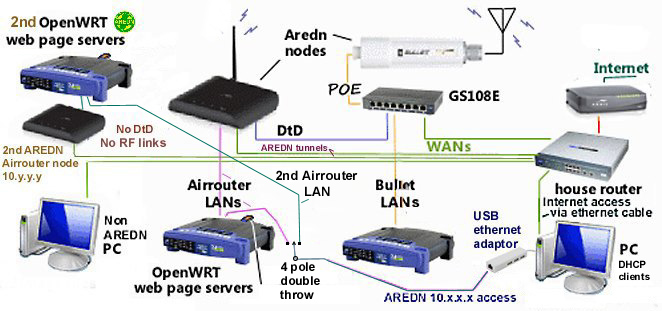| Connecting a PC to have AREDN mesh net access AND internet access, by using multiple NICs |
Found a way to give my PC access to the AREDN 10.x.x.x mesh network and still have access
to the Internet (this uses the effect of multiple network NICs (Network Interface Cards) in the same PC):
I have an ethernet cable going to the house router, and the PC gets with DHCP a
192.168.1.x IP address from it, and
I have, on an AREDN AirRouter node, via its LAN, a regular OpenWRT Linksys router with a
part 15 (non AREDN) 2.4GHz WiFi, the same PC getting another IP address
(also DHCP) from the AREDN AirRouter, 10.x.x.x. The PC has a built in WiFi system.
The PC seems okay with having two IP addresses.
The AirRouter has a tunnel connection to other AREDN nodes elsewhere in the world.
Now I can access AREDN sites as well as regular Internet web sites without
having to connect and disconnect cables.

Another similar method: I bought a USB to ethernet adaptor, and used it to replace the above wifi connection.
After the usual fiddling with drivers, it works now. In the diagram below, the OpenWRT Linksys
router that used to do the WiFi duty in the diagram at the top of this web page is now
operating as a switch on the AirRouter's LAN. The new USB to ethernet adaptor is
connected to this LAN via the OpenWRT Linksys router to the PC.
Using my web cam (it's an "advertised service" on the AREDN network) pointed at the
street where I live, this new connection offers more continuous
play of the camera video than the WiFi connection did. Wifi is in heavy use in my neighborhood. The OpenWRT router
also has a few web pages (as advertised services) on a thumb drive.

AA7AU mentions: "The way I have access to my LAN/WAN *and* to/thru my Mesh Node is to: - use a normal ethernet cable connection from the house router to the computer's RJ45 jack with normal DHCP from this house router; and, - connect an ethernet cable from my AirRouter/MikroTik/VLAN to my computer using a ethernet-to-USB adapter. (another way to do this is to add in a separate NIC card into your desktop computer with its own RJ45 jack). The AREDN AirRouter gives the PC using DHCP a 10.x.x.x IP address.
Depending on the mesh node firmware level I turn off "Gateway" or whatever setting it is that controls "default route" (this in the AREDN node), so that the Mesh Node only handles the 10.x.x.x traffic (and tunnel) thru the USB ethernet adaptor connection. That way everything except 10.x.x.x goes the normal path thru to the house router LAN and then the Internet, and only traffic on the 10.x.x.x space gets routed thru the AREDN mesh/tunnel. Works great with XP, Win7 and Raspberry PI linux."

If needed, you could have 3 nic's. This above example shows 2 independent AREDN networks, and the usual home internet network. However there is a flaw above. The address space (10.s.s.s and 10.y.y.y) on the two AREDN networks overlap The computer will try to send traffic to one of the two AREDN nodes, but not both. And none to the other. If you had non-overlapping IP address spaces then this could work, but as the AREDN node software automatically creates its IP address, one wouldn't be able to avoid this overlap. It's a combination of the first two systems. I placed the Wifi antennas right next to each other to drown out interference from neighbours.
A workaround to the above flaw is to use a 4 pole double throw switch to select one of the two AREDN nodes to connect to the PC.
This switch would switch the
orange pair and the green pair of the ethernet cables. If the cables are fairly short, less than 5 meters say,
the ethernet protocol seems to have no trouble handling the impedance bumps the switch wiring introduces.
The PC, a DHCP client, would get an IP address from the selected AREDN node, and another IP address from the house router connected
to the internet. When a link on the selected AREDN node and its network, there's no issue where to
send the 10.x.x.x traffic, as the other AREDN node is not connected at all. When the switch is thrown,
the PC gets a different DHCP IP address and now you can surf the other AREDN network.
